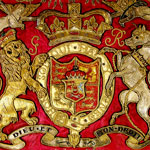A George III Royal Horse Guards Fanfare Trumpet Banner, Circa 1816
Adding product to your cart
Overall: 75cm (29.5in) x 65cm (25in)
Crimson damask, embroidered with the Royal Arms of 1816-1837 in silks, gold and silver bullion wire. Edged with a gold thread fringe. The present banner conforms to the design type first introduced in the reign of Charles II (1660-1685). Framed and glazed.
Provenance:
William Ould (fl. 1786-1818) Royal Horse Guards, Musician
James Ould (1801-1873) Coldstream Guards, Bass Trombonist
Musicians Edwin Ould and Charles Ould
Read more
The present fanfare banner is believed to have descended through several generations of musical family as the reverse bears the inscribed name of James Ould in a 19th century hand. Research suggests this James Ould was the son of Royal Horse Guards musician Sergeant William Ould. William, who was born at Chapel-en-le-Frith near Derby, was a soldier and musician of considerable experience, having joined the the Earl of Dartmouth’s Staffordshire Militia in 1786 at the age of eleven as a Drummer Boy. In 1797 King George III inspected the Staffordshire militia and was so impressed with its smart appearance that he ordered it to Windsor in 1799, 1800 and 1801, no doubt raising a few eyebrows amongst the Household Troops traditionally stationed there.
When the Staffordshire Militia was disembodied in 1802 during the temporary break in hostilities with France, the King expressed great regret at its departure from Windsor. However with the return of war he quickly ordered the return of the Staffordshire Militia to Windsor and personally led them into barracks. In 1804 Arthur Devis produced a painting of the Staffordshire Militia on parade at Windsor Castle, featuring their Band Master as a central figure. In 1805 the Militia band was reported in the Times playing alongsde those of the Foot Guards at Windsor. Throughout this period William Ould continued with the Staffordshire Militia but subsequently transferred as a musician into Royal Horse Guards at Knightsbridge in April 1814.
William Ould was discharged from the Royal Horse Guards at Windsor in 1818 ‘in consequence of inability from frequent attacks of Rheumatism leaving serious lameness in the right leg & thigh by which has been long totally unfit for military duties’. He was then described as ‘44 Years of Age, 5 Feet 7 Inches in Height. Lt. Brown Hair, Hazel Eyes, Dark Complexion, and by Trade or Occupation a Musician.’ Military music in the 19th century appears to have been something of a family affair. Accordingly James Ould found a place in the Coldstream Guards band in the 1820s. He went on to join Charles Godfrey's Surrey Zoological Gardens' band. His sons Edwin and Charles Ould were also musicians of some note. Charles, in 1862, married the granddaughter of Scots Guards' Bandmaster Edward Hopkins. He became a 'cellist of note in the Philharmonic concerts in the 1860's. Edwin became a double-bassist in the same orchestra.
Sources:
http://www.victorianlondon.org/entertainment/surreyzoologicalgardens.htm
Royal Hospital Chelsea : Soldier's Service Documents WO97/7/143
http://www.coldstreamguardsband.com/phpBB3/viewtopic.php?f=5&t=199&start=2620




